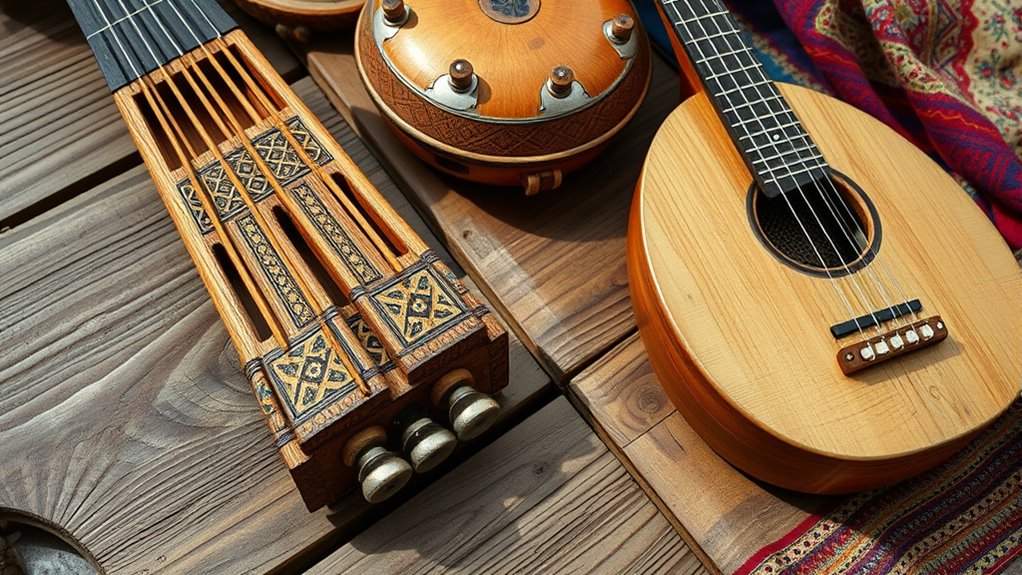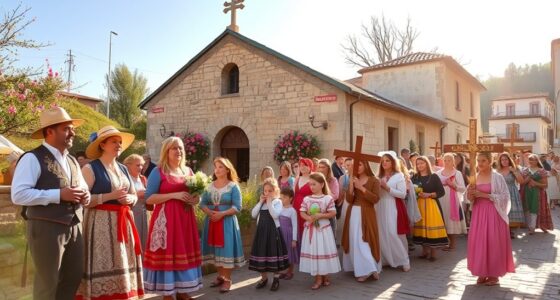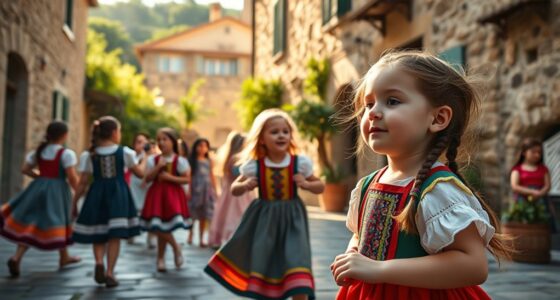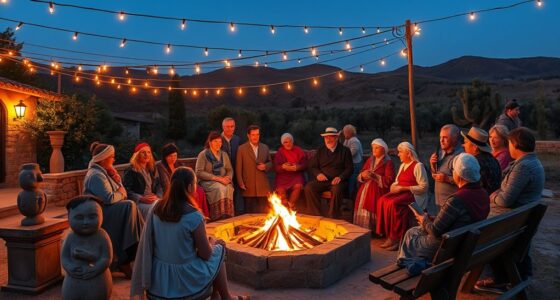Sardinian folk instruments are rich in history and cultural significance. You’ll find traditional tools like the launeddas, a complex, ancient wind instrument, and simple cane flutes such as the sulittu. Percussion instruments like drums and tambourines keep rhythms alive in social and religious events. Many of these instruments are handmade from local or recycled materials, reflecting Sardinia’s resourcefulness. Keep exploring to discover how these instruments shape the island’s vibrant musical heritage.
Key Takeaways
- Sardinian folk instruments include traditional wind, string, and percussion tools like launeddas, sulittu, and pipaiolu.
- Launeddas are iconic Sardinian reed instruments producing multi-layered sounds used in cultural and religious events.
- Instruments are crafted from natural, recycled materials using traditional, sustainable techniques passed through generations.
- They play vital roles in Sardinian festivals, dances, and rituals, supporting community identity and cultural heritage.
- Preservation efforts involve education, festivals, and digital platforms to keep traditional Sardinian instruments alive.
The Launeddas: Sardinia’s Ancient Wind Treasure

The Launeddas is an ancient Sardinian wind instrument that has endured for over 3,000 years, making it one of the world’s oldest continuous musical traditions. Originating from the Nuragic civilization around 1800 BC, its history is confirmed by artifacts like a 10th-century BC bronze statuette showing a musician playing a similar three-pipe instrument. Likely evolved from ancient Mediterranean reed instruments, the Launeddas remains unique and unbroken in Sardinia, unlike similar instruments once found across the Mediterranean. First documented in written records in the 13th century, it’s become a symbol of Sardinian cultural identity. Its survival results from rural communities’ dedication, preserving its traditional form and playing style through centuries of external influences and cultural change. The instrument’s deep roots in Sardinian culture have helped it to remain a vital part of local festivals and ceremonies, ensuring its transmission across generations. Additionally, the cultural significance of the Launeddas continues to inspire contemporary musicians and enthusiasts to keep this ancient tradition alive.
The Sulittu: The Traditional Cane Flute of Campidano
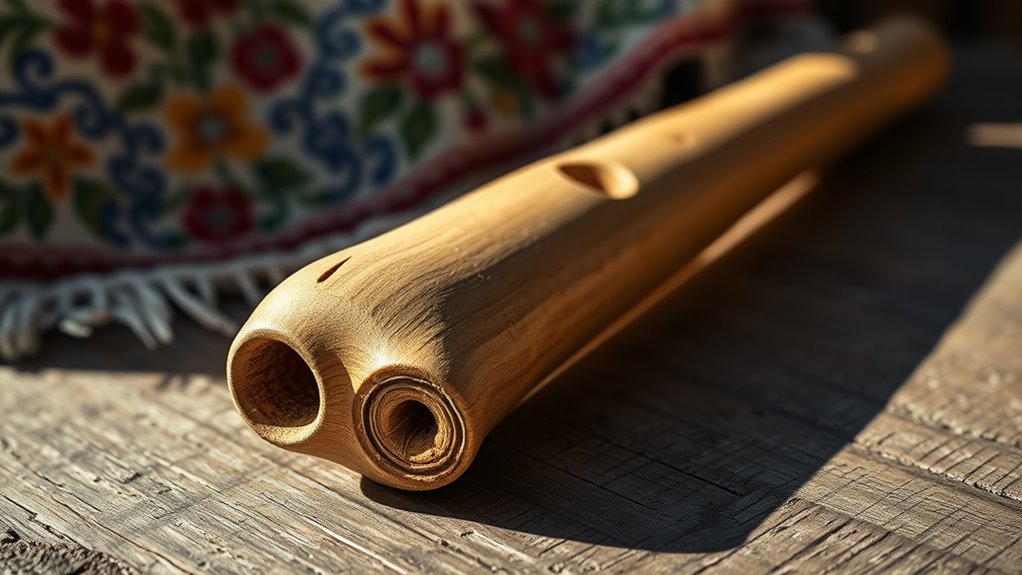
You’ll notice that the sulittu is crafted from a single piece of cane, with careful shaping of the beak and finger holes to produce a wide range of sounds. Its simple design and unique construction reflect traditional craftsmanship rooted in Sardinian rural life. As you explore its playing techniques and cultural role, you’ll see how this humble instrument holds deep community significance.
Craftsmanship and Materials
Crafting the sulittu involves carefully selecting a single piece of common cane, prized for its strength, hollowness, and flexibility, which are vital for producing a clear, resonant sound. The top end is cut at an acute angle to form the beak, essential for directing airflow and creating distinct notes. A natural knot in the middle of the cane influences the instrument’s acoustics and sound quality. The body includes a rectangular window just below the mouthpiece and four finger holes, all precisely cut to guarantee proper tone and ease of play. Traditional craftsmanship involves carving and shaping the cane to exact measurements, often with natural drying to prevent cracking. These materials and techniques highlight the connection between regional resources and the sulittu’s unique sound and durability. Additionally, the material’s sound properties contribute significantly to the sulittu’s characteristic tonal qualities, making it a distinctive instrument in Sardinian music.
Furthermore, understanding the material selection process underscores the importance of regional flora in shaping the instrument’s distinctive sound and resilience.
Playing Techniques and Sounds
Mastering the playing techniques of the Sulittu requires precise control of breath and finger placement to produce clear, sustained notes. You’ll use a continuous breath technique, similar to Sardinian launeddas, to keep sound flowing without interruption. Advanced players employ circular breathing, inflating their cheeks to sustain long melodic phrases seamlessly. Controlling breath pressure is essential to avoid tonal jumps and pitch fluctuations, ensuring smooth crossings. Proper positioning of the flute under your lips helps produce a stable tone. Beginners start by finding the right blowing angle and generating faint sounds, gradually increasing clarity and strength. Finger techniques involve covering rectangular holes to produce different notes, with simpler notes introduced first. Clean sealing of holes and subtle adjustments enhance tonal quality, making each sound expressive and authentic. Practicing regularly is crucial for developing muscle memory and improving overall tone control.
Cultural Significance
The Sulittu holds a deep cultural significance in Sardinian life, especially within the Campidano region. It symbolizes regional identity and reflects local musical heritage, connecting past and present. The instrument’s craftsmanship and performance elevate social status, with skilled players gaining recognition beyond their social class. It also embodies pastoral life and rural traditions, playing a key role in ceremonies and celebrations. The sound of the Sulittu is linked to storytelling, communication, and social dialogue, preserving oral customs. Additionally, the musical instrument serves as a symbol of community cohesion, reinforcing bonds among Sardinian villagers during festivals and gatherings.
Rhythms and Beats: Sardinian Drums and Percussion

Sardinian drums and percussion instruments create the heartbeat of traditional festivities and dances across the island. You’ll notice the *tumbarinos*, made from goat or sheep skins stretched over cork, wood, or recycled cheese molds, producing deep, resonant beats. During Carnival, smaller drums are played alongside *su pipaiolu* flutes and *su triangulu* triangles, especially on Fat Thursday. The *sa trunfa*, or Jew’s harp, adds a rhythmic shimmer with its unique sound, varying by region. Percussionists often use sticks or hands to craft hypnotic rhythms that support dances like *su ballu* and enhance folk melodies. These rhythms, tied to local traditions and natural materials, create an energetic, communal atmosphere that’s fundamental to Sardinian cultural identity. Traditional Sardinian music relies heavily on these percussion elements to keep the lively tempo and connect communities through shared celebrations. The use of natural materials in crafting instruments reflects the local craftsmanship that sustains cultural practices across generations.
Other Wind Instruments: From Benas to Pipiolos

Have you ever wondered how simpler wind instruments contribute to Sardinian music? These instruments, like benas and pipiolos, add unique sounds and textures to folk performances. Bens are broad term for traditional wind instruments made from cane or wood, often used in celebrations. Pipiolos are small cane flutes that produce soft, melodic tones, simpler than the complex launeddas. They typically have fewer pipes or a single pipe, making them easy to play. You’ll find these instruments serving as both accompaniment and solo pieces in folk ensembles. They’re commonly used during local festivals, dances, and small gatherings, enriching the musical landscape with their charming and straightforward sound. Their simplicity makes them accessible, yet essential to Sardinian musical traditions. Launeddas’s deep-rooted history highlights the significance of traditional wind instruments in Sardinian cultural heritage.
The Role of Accordion and String Instruments in Folk Music
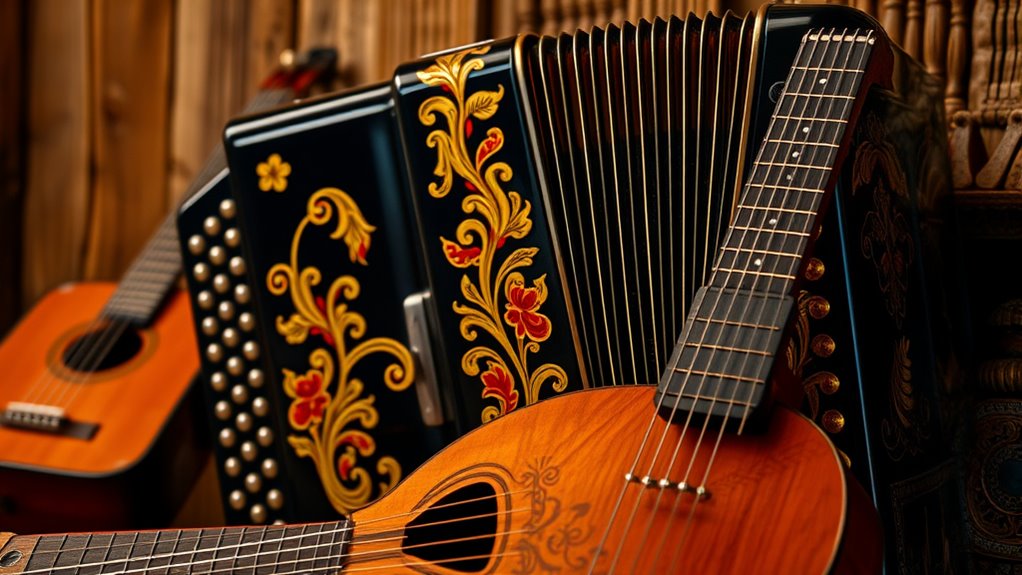
Accordions and string instruments play essential roles in shaping Sardinian folk music, often working together to create lively and expressive performances. The diatonic accordion, called *organittu* or *sonu*, is widely used to support singing, especially in *cantu a chiterra* traditions influenced by Spanish and Aragonese music. It provides harmonic and melodic support, driving dance rhythms in styles like *ballu sardo*. The guitar, introduced from Spain, is the primary string instrument and accompanies vocalists in regional singing styles such as *Mutu* and *Nuorese*. It offers both rhythmic strumming and melodic fills, often competing in festival contests. Together, accordion and guitar form the core of Sardinian folk ensembles, enriching performances at village festivals, dances, and religious events, and reinforcing regional musical identity. Recognizing the importance of professional help can also be crucial for preserving and promoting traditional music practices.
Cultural Significance of Sardinian Musical Instruments
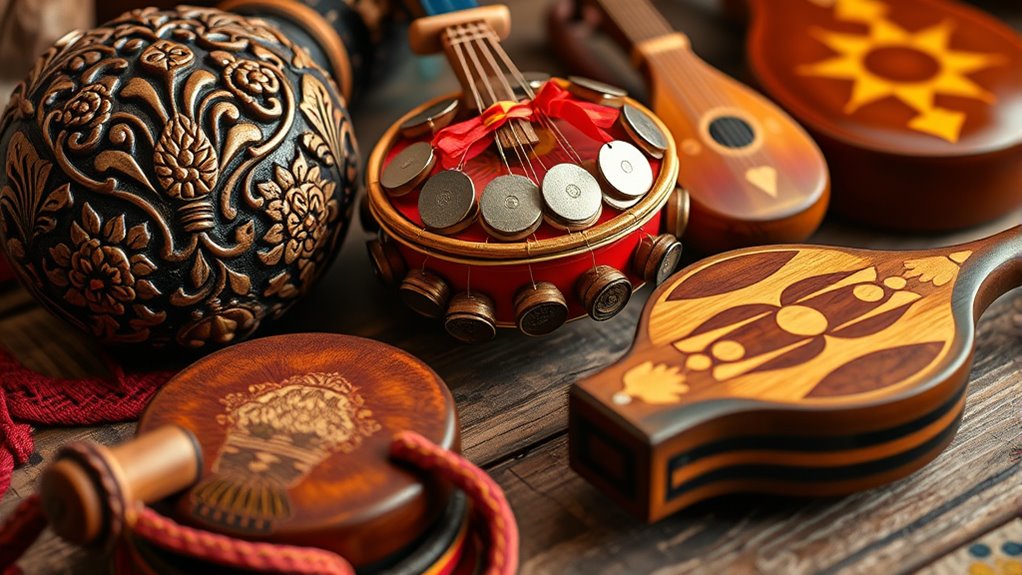
The cultural significance of Sardinian musical instruments runs deep, reflecting the island’s rich history, spiritual life, and national identity. These instruments, like the ancient launeddas, symbolize Sardinia’s enduring cultural heritage, dating back over 3,000 years. They connect communities through rituals, religious ceremonies, and social gatherings, preserving traditional values. You’ll find that:
Sardinian instruments like launeddas embody centuries of cultural heritage, connecting communities through sacred and social traditions.
- Launeddas serve as symbols of Sardinian identity, showcasing unique sound and craftsmanship.
- Instruments are used in sacred rites, festive processions, and communal dances, intertwining music with spiritual life.
- Local materials and sustainable practices highlight a strong link between nature, history, and cultural expression.
- Many of these instruments are crafted using recycled materials, emphasizing the community’s resourcefulness and environmental consciousness.
- The craftsmanship involved often employs traditional sustainable practices, ensuring the preservation of cultural techniques and environmental harmony.
Together, these elements reinforce a shared sense of pride and continuity, making Sardinian folk instruments essential to the island’s cultural fabric.
Traditional Sardinian Songs and Dance With Instruments
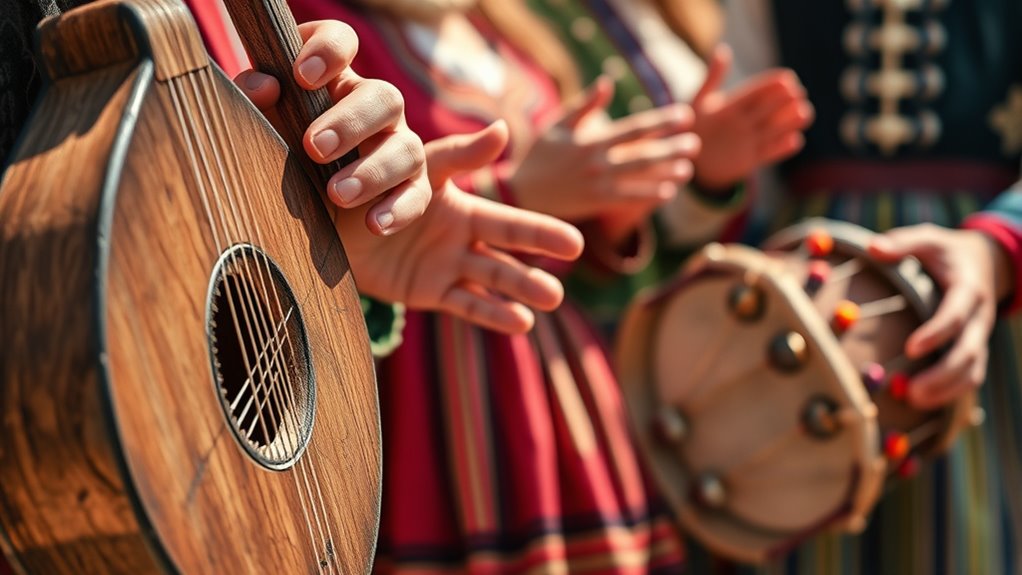
You’ll see how instruments play essential roles in Sardinian songs and dances, shaping rituals and celebrations. They provide rhythm, melody, and harmony, often working together to create lively performances. These musical elements highlight the rich tradition of polyphony and communal expression across the island. For instance, the launeddas, an ancient instrument played using circular breathing, are used in complex music styles and religious ceremonies, showcasing Sardinia’s deep musical heritage with notable players like Efisio Melis and Luigi Lai. The cultural significance of these instruments underscores their importance in maintaining Sardinian identity and tradition.
Instrumental Roles in Dance
In Sardinian folk dance, instrumental music plays a pivotal role in guiding and energizing performers, with each instrument contributing to the overall rhythm, melody, and atmosphere. The launeddas, the most ancient wind instrument, produce complex layers that mark tempo changes and support both fast and slow dance steps. Supporting instruments like the guitar, accordion, and piffero add harmonic depth, while percussion keeps the lively rhythm essential for dancing. Jew’s harp and mouth organ introduce distinctive tonal colors, enhancing the musical texture. The launeddas, with their intricate, multi-layered sounds, are often considered emblematic of Sardinian musical identity. – Launeddas set the dance’s rhythmic foundation and guide dancers’ pace. – Guitar and accordion provide harmonic support during tempo shifts. – Percussion emphasizes beats, signaling shifts and energizing the group.
Rituals and Celebrations
Traditional Sardinian rituals and celebrations showcase vibrant performances of local music and dance, where instruments like launeddas, accordion, and tambourines play essential roles. During events like the Cavalcata Sarda, local bands perform lively music that accompanies traditional dances, such as the round ball (ballu tundu). The Ardia horse race combines music and ritual, with lively songs and rhythms highlighting medieval-inspired battles. Launeddas, a key instrument, feature in religious processions, Masses, and carnival rituals, often played with circular breathing to sustain continuous sound. Percussion instruments like tambourines add rhythm, while accordion melodies support monodic songs and dances. These musical elements help reinforce community bonds, celebrate Sardinian heritage, and keep ancient traditions alive through spirited performances.
Polyphony and Song
Have you ever wondered how Sardinian villagers create such powerful and intricate harmonies? It’s through their unique polyphony, like cantu a tenòre and cuncordu, rooted in pastoral life and ancient Nuragic culture. You’ll see groups of four men with distinct voices—bassu, contra, boche, mesu boche—working together in close circles. Their deep, guttural tones define the sound, blending spontaneous singing with dance and storytelling. Achieving harmonic layering through overtone singing is essential to creating the rich textures that characterize Sardinian polyphony. Key aspects include: – Achieving polyphony through overtone singing and harmonic layering – Performing serenades, dance songs, and poetic laments – Incorporating regional styles like cantu a tenòre and cuncordu, each with local variations Whether singing sacred or profane songs, these traditions remain essential, even as modern influences reshape them.
Preserving Heritage: Modern Day Use and Teaching of Instruments
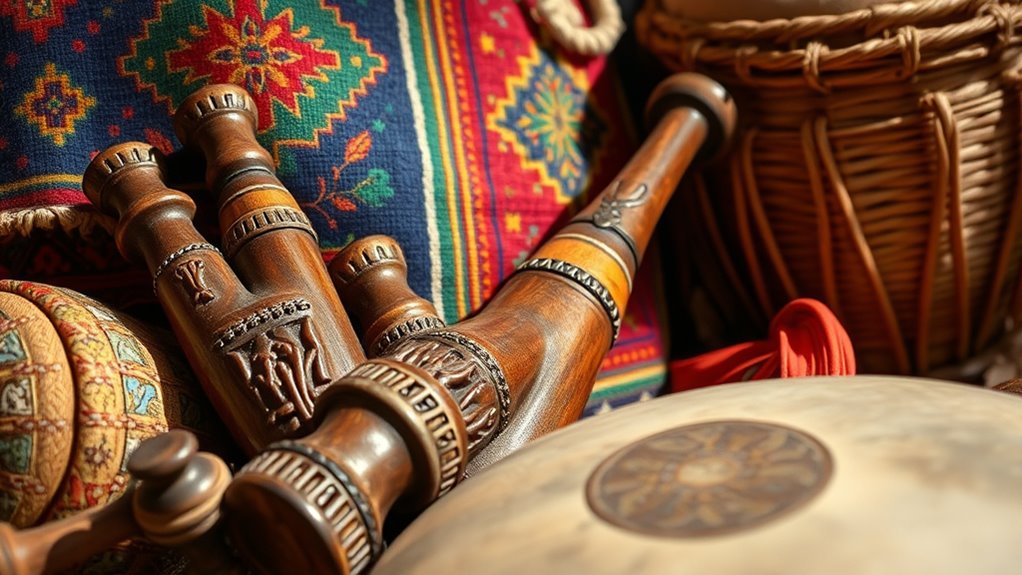
Preserving Sardinian folk instruments today involves a dynamic mix of formal education, community engagement, and digital innovation. You can learn these instruments in dedicated music schools and cultural institutions across Sardinia, where workshops and masterclasses are regularly organized by experienced players. Some regional conservatories include Sardinian folk music in their curricula, promoting formal learning alongside classical studies. Festivals and cultural events often feature educational activities, encouraging young people to explore traditional instruments. Collaboration with ethnomusicologists helps document and systematize teaching methods. These instruments, such as the launeddas and pipaiolu, continue to play essential roles in religious ceremonies, dances, and festivals. Meanwhile, online tutorials, social media, and digital recordings expand access, ensuring that Sardinian musical heritage remains vibrant and relevant today. Digital platforms have also become vital tools for connecting musicians and enthusiasts across different regions, fostering a community that values and perpetuates this cultural legacy. Additionally, cultural preservation initiatives aim to safeguard these traditional practices for future generations.
Frequently Asked Questions
How Are Sardinian Instruments Traditionally Crafted and Maintained?
You get a glimpse of traditional Sardinian instrument crafting through careful selection of local materials like cane, wood, and leather. You shape and assemble parts using age-old techniques, paying attention to details like finger holes and membrane tension. Regular maintenance involves keeping instruments dry, checking for wear, and replacing parts when needed. This craft is passed down through generations, preserving Sardinian culture and ensuring each instrument’s unique sound and heritage.
What Are the Regional Differences in Sardinian Folk Instrument Styles?
You’ll notice regional differences in Sardinian folk instrument styles that reflect local traditions and cultural identities. For example, launeddas vary in repertoire and ceremonial uses across central-southern villages, while guitars differ in body shape, tuning, and ornamentation depending on the region. Polyphonic singing styles like *cuncordu* and *cantu a tenòre* also showcase regional diversity, highlighting unique vocal arrangements and social functions. These variations make Sardinian music rich and deeply rooted in local customs.
How Do Sardinian Instruments Influence Contemporary Sardinian Music?
Imagine traditional Sardinian instruments as the roots deep in your musical tree, shaping its growth. They influence contemporary Sardinian music by weaving ancient sounds into modern genres, like vibrant threads in a tapestry. You’ll find these instruments blending seamlessly with pop, jazz, and experimental styles, creating a rich, authentic sound. This fusion keeps Sardinian culture alive, allowing you to experience a musical journey that honors tradition while embracing innovation.
Are Sardinian Instruments Used in Modern Popular Music Genres?
Yes, Sardinian instruments are actively used in modern popular music genres. You’ll find traditional instruments like launeddas and Sardinian guitar integrated into styles such as pop, rock, reggae, and jazz, creating unique sound textures. Musicians adapt these instruments with modern techniques, blending traditional melodies and texts into contemporary arrangements. Festivals and media showcase this fusion, helping these instruments gain recognition worldwide and inspiring new musical experiments.
What Training Methods Are Used to Learn Sardinian Traditional Instruments?
Did you know that learning Sardinian traditional instruments often takes years of apprenticeship? You’ll mainly rely on oral transmission, listening and imitating masters rather than formal notation. You start with simple religious tunes, gradually progressing to complex dance music. Mastering circular breathing, finger control, and managing breath flow are essential. Training also includes understanding instrument maintenance, participating in social events, and sometimes attending workshops or master classes to deepen your skills and cultural understanding.
Conclusion
Now that you’ve explored Sardinian folk instruments, you see how they keep traditions alive and vibrant. These instruments aren’t just relics; they’re the heartbeat of Sardinian culture. Whether you’re a music lover or a curious traveler, remember that understanding these sounds is like hitting the nail on the head—truly enriching. So, dive deeper, and let these melodies open a whole new world for you. The ball’s in your court now!
